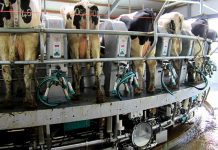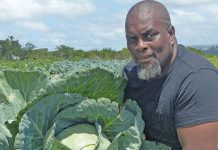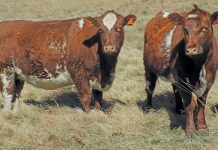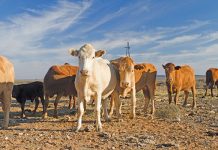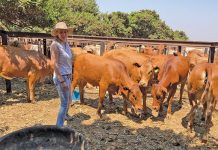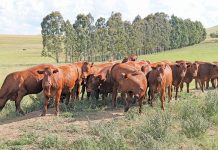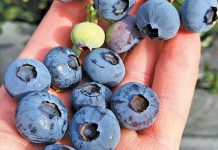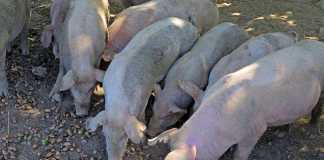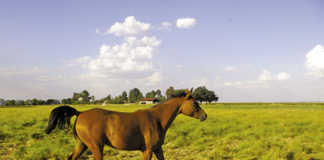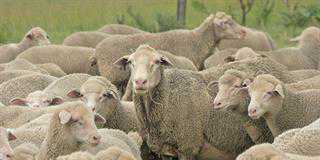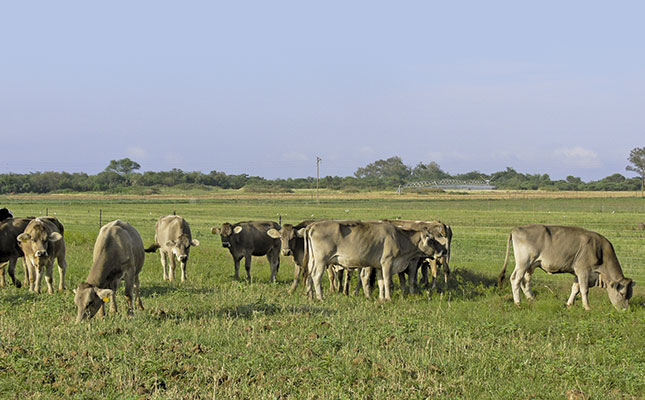
Photo: Chris Nel
Cois Harman and his wife Annemarie established their Harman Braunvieh stud on the farm, Welverdiend, in the Marico bushveld in North West in 1998. Their choice of Braunvieh was based on the breed’s excellent dual-purpose characteristics and performance.
READ: Know your cattle: Braunviehs
The scenic Marico bushveld, synonymous with author Herman Charles Bosman, is typified by rich floral biodiversity, including more than 50 prominent tree species and game such as kudu, impala, bush buck, duiker and steenbok. Carnivores include black-backed jackal, caracal, serval and leopard. The area’s birdlife is equally diverse.
Changing from milk to meat
Initially, Cois milked the cows directly from the veld and supplied milk to the then National Co-operative Dairies (NCD). When NCD withdrew from the area, he supplied the milk to a local dairy. Owing to the dairy industry’s erratic nature and the fact that he farms part-time, Cois abandoned commercial milking, leaving the calves with their dams.
In September 2004, Cois introduced a programme, which he still uses today, to weigh all cattle at stipulated times. Now with their dams, he found that the calves were growing considerably faster. But when several calves were killed by leopards, Cois was forced to separate them from their dams at night, keeping them in a kraal.
Then he noticed that those calves sired by certain bulls grew faster than others. He started taking the bull calves that showed the most potential in each year’s crop to Armoedsvlakte in Vryburg for phase-C testing. The other bull calves undergo phase-D growth tests in Welverdiend. Following the test results, the best performers are made available on the bull market while the others are culled and slaughtered.
Cois expanded his operation in 2011, moving his operation to the farm, Veeplaas, situated where the Klein Marico River joins the Groot Marico River. Here he established pasture under irrigation and started to milk again, making cheese from the Braunvieh’s high-quality milk.

Cois and Annemarie Harman of the Harman Braunvieh Stud.
Photo courtesy of Cois Harman.
Choosing the Braunvieh as the ideal dual-purpose breed
In the North West bushveld, where no substantial commercial dairy industry exists, cows are commonly milked from veld or pasture. In this respect, the Braunvieh outperforms other breeds due to its walking and foraging ability and the high-quality milk produced from veld forage.
“It’s a well-adapted breed that provides a monthly cash flow from the milk it produces,” explains Cois.
It is for these reasons, coupled with the breed’s practical production characteristics – exceptional beefiness, excellent growth, meat quality, and docile temperament – that Cois chose to farm Braunvieh.
READ: Dexter cattle: Ideal for meat and dairy production
“In a commercial herd, a Braunvieh bull can increase the weaning weight of the calves by up to 50kg more than calves sired by other breeds. Also, the breed produces high-quality purebred and crossbred calves,” he says.
The Braunvieh breed’s many strengths means that it is in high demand, and owing to the excellent performance of Cois’s herd, many cattlemen, particularly from Botswana, regularly buy Braunvieh heifers, cows and bulls from the Harman Braunvieh Stud.
The selection process
Cois selects for growth, good post-weaning weight gain in relation to feed intake, hardiness and adaptability, calving ease and small calves that grow quickly. Characteristics that he favours include length, depth, muscular development, above-average milk production (more than 10l daily on the veld), longevity, temperament, maternal characteristics and productivity, as well as fertility and reproduction.
Bull calves undergo phase-C and phase-D testing through the ARC’s performance testing scheme.
“I cull and slaughter those that don’t perform satisfactorily, along with cows that don’t make the grade,” he says.
Heifers are put to the bull or artificially inseminated between 18 and 20 months, to calve before 30 months.
Recording and culling for the best genetics
The herd is weighed regularly and Cois keeps records of the performance of each genetic line. Whether by direct mating or artificial insemination, he only uses bulls that perform well and distinguish themselves in the herd, thereby ensuring that the herd remains at the forefront of the breed and contributes to progress in other Braunvieh herds.
“A cattleman who buys a bull from us must be satisfied with the impact it has on his herd,” he says.
Should a genetic line perform unsatisfactorily, he culls the progeny.
“It’s better to get rid of cattle that don’t adapt to the area because they cost us money,” he stresses.
Cois favours lines that are tough, adaptable, and productive, and cows failing to produce annually are culled – as is common in any efficient beef production operation.
Phone Cois Harman on 087 808 3198, or email him at [email protected]. For more information, visit www.harman.co.za.
This article was originally published in the 16 January 2015 issue of Farmers Weekly.

